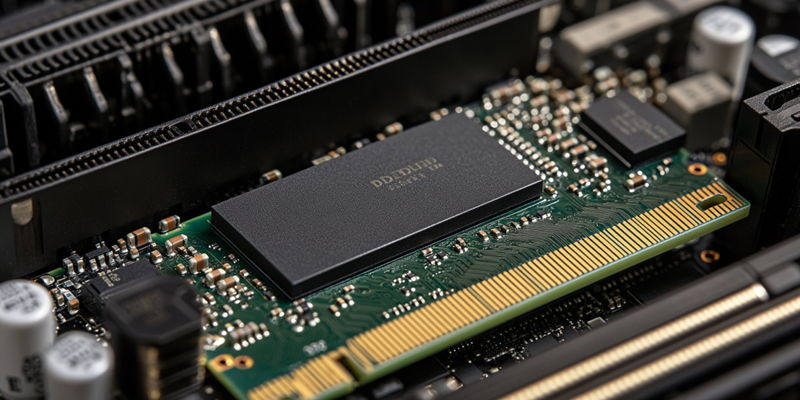In a significant leap forward for computer hardware, Asgard has unveiled its advanced DDR5 CUDIMM memory kit, branded as THOR, which promises unprecedented speeds of up to 9600 MT/s. This innovation is set to challenge the status quo of existing high-speed DDR5 RAMs by greatly enhancing signal integrity and overall memory performance. The THOR memory kit’s cutting-edge features include the Clocked Unbuffered Dual In-Line Memory Module (CUDIMM) technology, which leverages a Clock Driver (CKD) to regenerate the clock signal. This functionality doesn’t just improve stability; it also enables the RAM to achieve higher frequencies, effectively eliminating signal transmission bottlenecks between the CPU and DRAM. This translates to a noticeable boost in performance, with the memory kit operating at an impressive 9600 MT/s at CL 44 latency. When compared to other memory kits, this performance is akin to a 6400 MT/s DDR5 running at CL 30, offering remarkable bandwidth and responsiveness.
Advanced CUDIMM Technology and Performance Comparison
The Clocked Unbuffered Dual In-Line Memory Module (CUDIMM) technology stands as one of the most innovative aspects of the THOR DDR5 memory kit. Traditional RAM modules often face challenges such as signal degradation and timing issues, which can limit their performance. CUDIMM tackles these issues head-on by incorporating a Clock Driver (CKD) that regenerates the clock signal, ensuring stable and consistent performance even at higher frequencies. This pioneering technology minimizes signal transmission delays between the CPU and DRAM, effectively enhancing overall system stability and memory efficiency. By eliminating bottlenecks, CUDIMM allows the RAM to perform at its peak, achieving groundbreaking speeds that were previously thought to be unattainable in mainstream consumer hardware.
Comparing Asgard’s THOR DDR5 memory kit to other high-speed RAMs further highlights its exceptional capabilities. The THOR operates at a speed of 9600 MT/s with a latency of CL 44, which is a notable achievement in itself. In practical terms, this performance is comparable to a 6400 MT/s DDR5 memory running at CL 30 in terms of bandwidth and efficiency, but with the added advantage of higher frequency. Such a comparison underscores the THOR memory kit’s ability to deliver superior performance and responsiveness, making it a formidable contender in the high-speed memory market. This milestone not only sets a new benchmark for memory speeds but also signals a significant advancement in memory technology, paving the way for future innovations that push the boundaries of what’s possible in computing performance.
Compatibility and Future Developments
The Asgard THOR DDR5 memory kit’s compatibility with the latest AMD and Intel platforms underscores its versatility and potential for widespread adoption. Designed to support platforms that can handle much higher clock speeds, this memory kit ensures that users can easily integrate it into their existing systems without worrying about compatibility issues. This broad compatibility is further bolstered by the use of third-generation JEDEC-compliant chips, which guarantee reliability and stability across a range of new systems. Additionally, the memory modules support Intel XMP, allowing users to optimize settings effortlessly at a voltage of just 1.5V. Such features make the THOR memory kit not only powerful but also user-friendly, appealing to both enthusiasts and mainstream users alike.
Looking ahead, Asgard’s ambitious plans to develop a 10,000 MT/s memory kit are a testament to the company’s commitment to pushing the boundaries of memory technology. By continually striving to achieve higher memory speeds and performance levels, Asgard is positioning itself as a key player in the rapidly evolving computer hardware market. These future developments promise to bring even greater advancements in memory performance, further enhancing computing capabilities and user experiences. The company’s focus on innovation and performance refinement indicates that we can expect more groundbreaking releases from Asgard in the near future, solidifying their status as a leader in the high-speed memory sector.
Aesthetics and Market Trends
The Asgard THOR DDR5 memory kit stands out for its compatibility with the latest AMD and Intel platforms, showcasing its versatility for widespread use. It’s designed to support higher clock speeds, ensuring users can integrate it into their current systems seamlessly. This flexibility is enhanced by its third-generation JEDEC-compliant chips, which provide reliability and stability for new systems. Additionally, the modules support Intel XMP, allowing users to effortlessly optimize settings at just 1.5V. These features make the THOR memory kit both powerful and user-friendly, appealing to enthusiasts and mainstream users.
Looking to the future, Asgard’s plans to develop a 10,000 MT/s memory kit highlight the company’s dedication to advancing memory technology. By aiming for higher memory speeds and improved performance, Asgard is positioning itself as a leader in the evolving computer hardware market. These upcoming developments promise to boost memory performance, enhancing computing capabilities and user experiences. Asgard’s continuous focus on innovation and performance means we can expect more groundbreaking products soon, reinforcing their leadership in the high-speed memory sector.

